See the latest kit improvements at Midlands Machinery Show
There are plenty of new or improved bits of kit for interested customers to check out at the upcoming Midlands Machinery Show, taking place at Newark Showground on 23 and 24 November.
The Farmers Weekly machinery team have picked out some of the innovations worth running your eyes over, including a new trailed sprayer from Landquip and an updated Leader4 range from Team Sprayers.
See also: New Holland buys Kongskilde cultivation and drill kit ranges
Root crop growers will be treated to a sleeker UniPlus destoner design by Ely-based manufacturer Standen Pearson, while a crop washer is on display from first-time exhibitor Haith Group, offering a high-output, energy-efficient solution for cleaning produce ready for market.
Mzuri will bring updated coulters to fit its range of drills, while KRM-Bogballe spreader users can now variably control fertiliser applications through a tablet computer.
Finally, those making and handling bales will be interested to see a square bale collector, wrapper and self-loading round bale trailer from Canadian firm Andersons.
Trailed sprayer for smaller tractors
Landquip are launching a new trailed sprayer intended for growers operating an 80-120hp tractor who want plenty of capacity, without too much technology.
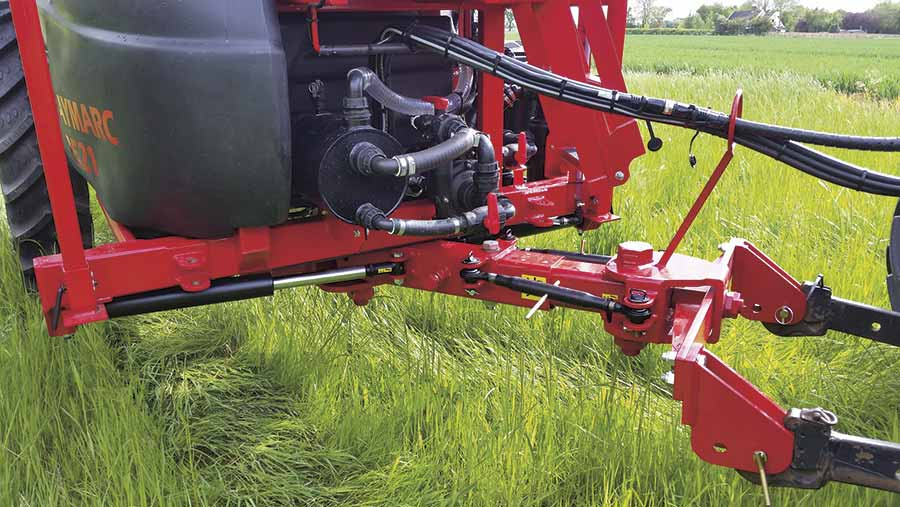
Landquip Spraymarc
The Spraymarc will be available in 2,500-litre and 3,000-litre sizes, equipped with aluminium booms up to 28m and carried on a high-lift parallelogram linkage with hydraulic tilt and trapezium self-levelling suspension.
Spraying equipment includes a 30-litre chemical bowl with can wash, rinse and agitation jets and a choice of pto-driven piston diaphragm pumps with 210- or 300-litres/min capacity.
There is also a hydraulic-drive 700-litres/min centrifugal pump option with self-priming.
A rate-controlled Arag Bravo 300S is included as standard, but can be upgraded to the Bravo 400S with 4.7in GPS guidance screen and auto-nozzle switching.
Richard Abbot of Landquip highlights the choice of drawbar set-ups – the Spraymarc can be equipped with a non-tracking drawbar for pick-up hitch or ball-and-spoon couplings.
There is also a tracking drawbar to minimise wheelings with all-mechanical, hydraulically cushioned or electronically controlled all-hydraulic operation.
The sprayer’s rigid axle – with manual track adjustment between 1,500mm and 2,200mm – provides 700mm underbelly clearance when fitted with 380/85R 38 tyres on row-crop rims.
Haith shows off new high-output root crop washer
First-time exhibitor Haith Group will use the event to unveil its Tri-Wash process washer for root vegetables.
Designed to increase washing efficiency for crops grown on soils with a high stone content, the system brings together a bed of transverse brushes, a destoner, an immersion tank with jacuzzi agitation and mechanisms for removing sludge and surface debris.
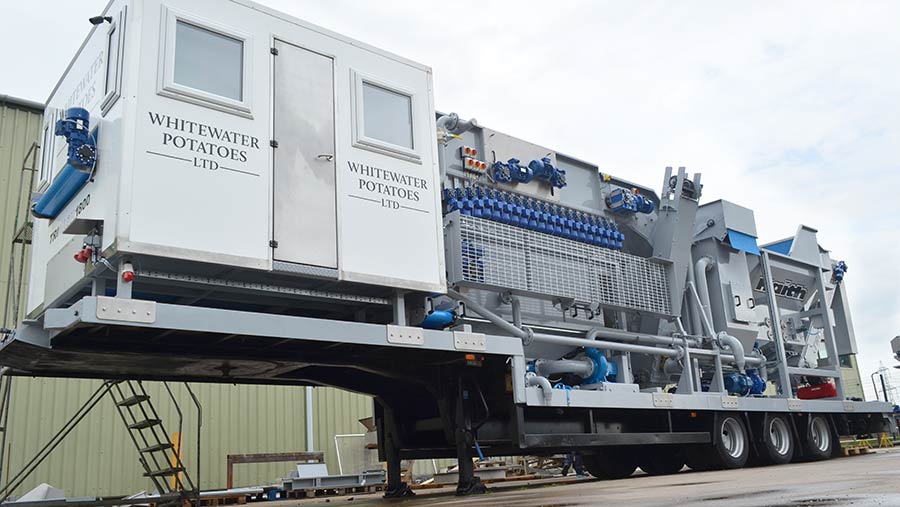
Haith Tri Wash
Typically mounted on a step-frame lorry trailer for easy transportation between sites, the Tri-Wash can also be installed in a static location.
It comes equipped with a fully insulated and heated fibreglass inspection cabin, remote-control panel and CCTV monitoring.
Haith says the new set-up aims to provide effective cleaning at high output, using the least amount of water and energy, with low maintenance requirements.
Control variable-rate applications from your tablet
Tablet computer control of KRM-Bogballe fertiliser spreaders is being extended to include variable application rates.
The new feature being highlighted at the show joins existing functions, which include touch-screen spreader operation, auto stop/start and headland section control and straight or curved A-B line guidance.
KRM’s iZurf Wi-Fi Control uses a wireless communication module to link a free Android tablet app to the Calibrator Zurf controller plugged into the spreader and can receive position data from an existing GPS reciever.

KRM Bogballe Calibrator
It can also connect to non-GPS variable-rate devices such as the Yara N-Sensor and Claas Isaria crop sensing systems, and to external variable-rate treatment units including the Soyl Opti, iSoyl and Patchwork devices.
Using a tablet is becoming increasingly popular for machine control, as it provides full control of all spreader functions, which is not possible with an Isobus virtual terminal, says Keith Rennie of KRM.
Harnessing the typical ease of use and touchscreen colour display of an Android tablet provides a means of setting and operating the spreader regardless of the GPS service provider and tractor make.
The app also provides online access to spread charts by product, chart number or fertiliser analysis, and to instruction books and videos, local weather forecasts and email for job reports and contractor invoicing.
Mzuri updates drill coulter options
Drill maker Mzuri will feature its Dual Row coulter for the first time at the show, along with a revised single-row coulter for its Pro-Til seeder.
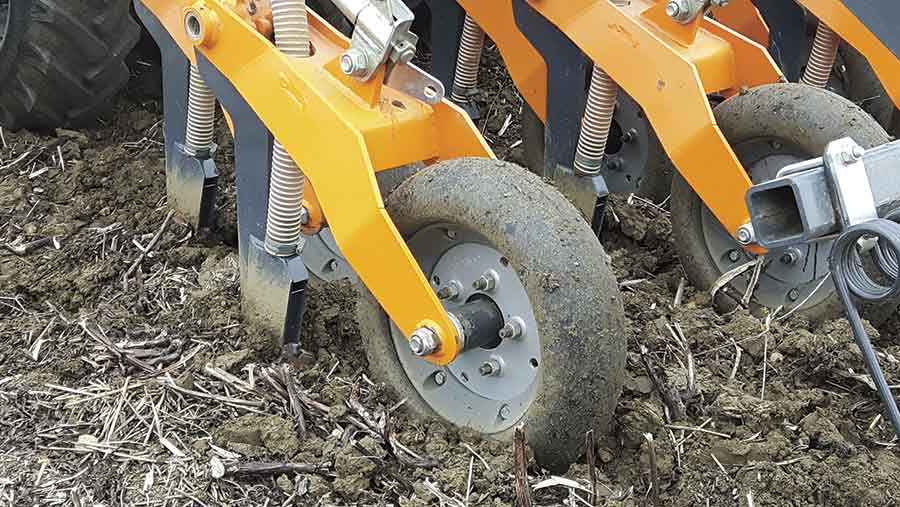
Mzuri dual-row coulter
Martin Lole of Mzuri explains that reducing wear and tear and driving down running costs is behind the changes, achieved by revising component layout and coulter leg geometry.
This means only points come into contact with the soil at a more vertical angle, minimising metal abrasion.
The updated coulters are also quicker to fit, he says, because only the tungsten-tipped points need replacing when worn.
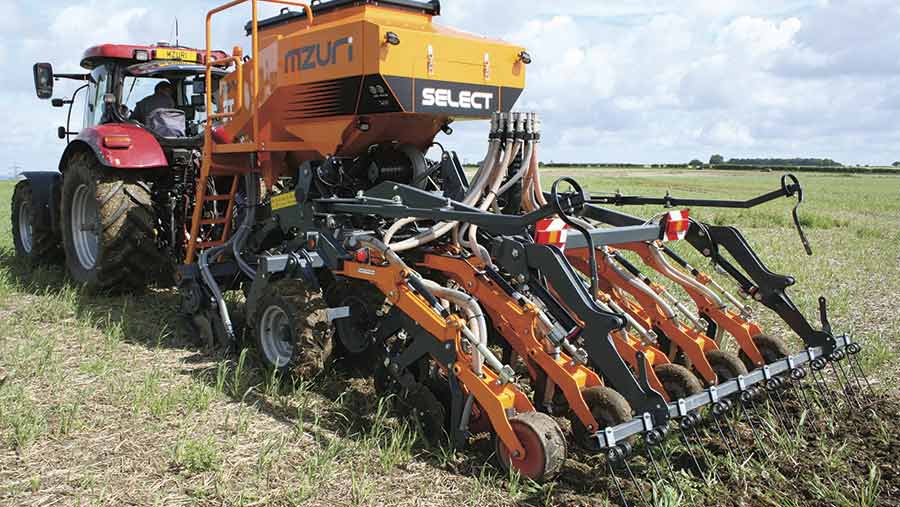
Mzuri Select
Designed to deliver more precise seed placement, the coulter leg incorporates an integral seed distribution unit, complete with a vent to regulate air pressure.
The Dual Row coulter option places seed in 140mm bands, with a marginally wider spacing between them to encourage good crop light interception.
It is recommended for sowing cereals and other combinable crops and can be ordered with new Pro-Til drills or retrofitted to existing machines.
Sleeker destoner is easier to handle
Standen Engineering’s new UniPlus stone and clod separator features a redesigned chassis and a range of separation options is now available to growers.
According to David Wilson of Standen, the new separator – in star plus underweb format – provides more thorough separation, while the availability of an all-web version for the first time caters for potato growers on lighter soils.
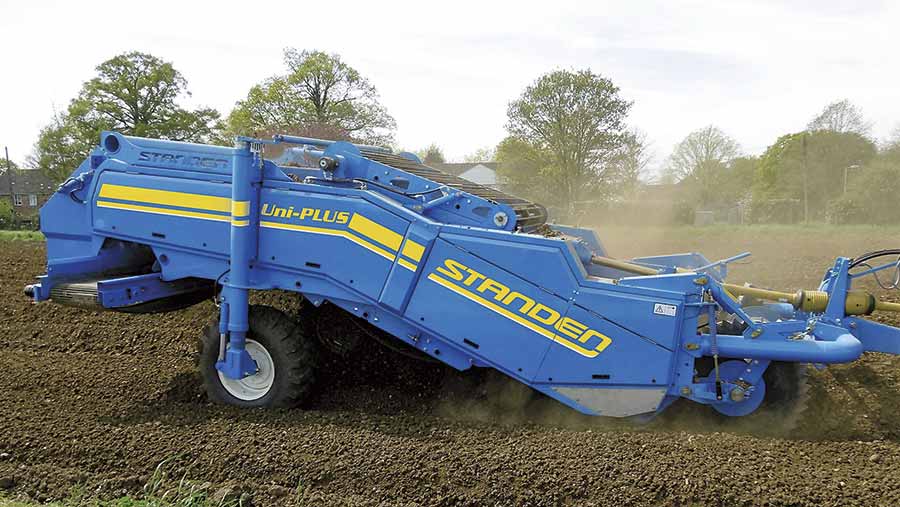
Standen Engineering Uni Plus
Both versions are built with a sleeker chassis and tighter steering for improved manoeuvrability and the working elements are set at a slightly steeper angle to increase separation potential.
On the four-web version, the first three webs are of the same size so they can be moved to different positions to even out wear and minimise running costs.
The all-star version comes with an underweb to permit a more open roller arrangement while taking out small stones.
It has 10 rows of stars that are injection moulded from a more durable material while retaining the 32cm-diameter and double-helix installation for maximum separation performance.
Simplified auto-depth control and an overweb with hydraulic adjustment are installed and the previous notched belts have been replaced by multi vee-belt drives capable of transmitting high power loadings with improved efficiency and a significant built-in safety margin, according to Standen.
The Uni-Plus separators are available in 1,700mm and 1,500mm working widths, with options including a hydraulic boulder box, hydraulic breakaway drawbar and a reversible scrubber web for enhanced clod breakdown, especially when working downhill.
Leader4 sprayer set for smoother ride
Load-sensing air suspension for a smoother sprayer and boom ride is a feature of the new steering axle fitted as part of a package of upgrades on the Team Sprayers’ Leader4.
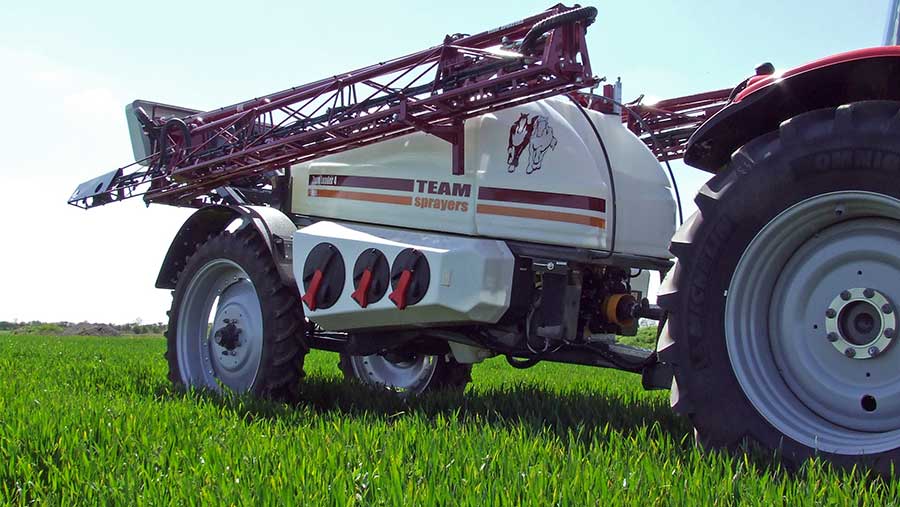
Team Sprayers Leader4
Available in 3,000-, 4,000- and 5,000-litre sizes with 21-32m booms – larger sizes being triple-fold – the Leader4 has a shapelier tank to lower the centre of gravity for increased stability, which is enhanced for track and road travel by a boom designed to fold to a lower stowed position.
A Müller Basic terminal operates all functions and through-boom circulation keeps the sprayline ready for an immediate response to the “spray on” command.
Canadian bale handling solutions on show
A big, square bale collector-stacker that logs bale weights in the process is one of three equipment ranges being introduced by D Clifford & Sons, newly appointed distributor for Canadian manufacturer Andersons.
For the UK market, Cliffords has decided to begin with the StackPro square bale collector, self-loading TRB round bale trailer and an in-line bale wrapper, which can wrap either round or square bales in a continuous tube.
The Stack-Pro collects square bales of all major sizes, with the non-stop action of its adjustable loading arm said to pick up bales without dragging or damaging them.
Bales are picked up end-on before being pivoted through 90deg as they are lifted and laid on a platform at the front of the machine.
Once two bales are in place, the platform is pivoted upwards to create a stack that is set down vertically at the point of storage.
Electronic digital controls that operate the machine include a weighing system that tallies both the total number and weight of bales picked up, as well as the average bale weight.
The TRB round bale trailer is equipped with large flotation tyres on tandem axles to minimise its impact on the soil.
Bales are lifted on board into a set of three before being pushed down the bed ready for the next three. The deck is simply raised at the storage point and trailer driven from beneath the bales.
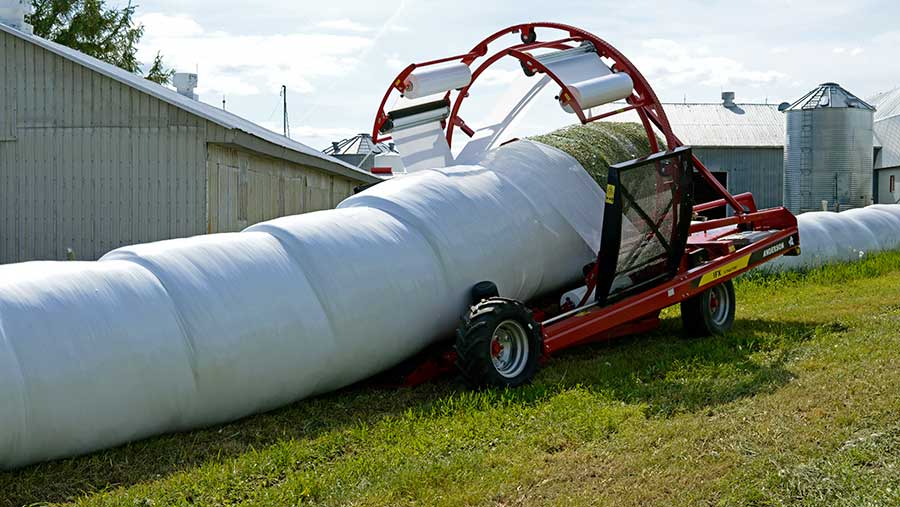
Andersons IFX660 inline wrapper
Andersons’s in-line wrappers are self-propelled machines that can wrap either round or square bales in a continuous tube.
The control system enables lines of bales to be positioned close together without the risk of damaging adjacent lines, so storage space is optimised and any headland or flat area can be used for weather-protected forage storage.
The machine presses bales together before wrapping them to exclude air and preserve forage quality, before its rear conveyor drops to the ground, laying bales down gently and removing any danger of damage.

